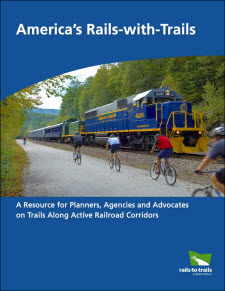 The Rails-to-Trails Conservancy (RTC) published a report that examines the characteristics of 88 existing rails-with- trails in 33 states. Rails-with-trails are trails located adjacent to active rail lines. They can be valuable assets in providing safe transportation for pedestrians and bicyclists. The RTC report is based on a survey of trail managers and RTC's ongoing study of rails-with-trails. It provides a collection of data, examples, and practical tools to assist trail planners and advocates in (1) increasing awareness of the rail-with-trail concept, and (2) advancing local and state policies and practices that support rail-with-trail development.
The Rails-to-Trails Conservancy (RTC) published a report that examines the characteristics of 88 existing rails-with- trails in 33 states. Rails-with-trails are trails located adjacent to active rail lines. They can be valuable assets in providing safe transportation for pedestrians and bicyclists. The RTC report is based on a survey of trail managers and RTC's ongoing study of rails-with-trails. It provides a collection of data, examples, and practical tools to assist trail planners and advocates in (1) increasing awareness of the rail-with-trail concept, and (2) advancing local and state policies and practices that support rail-with-trail development.
The report updates previous similar reports from RTC with new information on national rail-with-trail trends, and complements the report produced by the U.S. Department of Transportation (USDOT) in 2002, "Rails-with-Trails: Lessons Learned."
Key findings are that multi-use trails alongside active freight, passenger, and tourist rail lines are safe, common, and increasing in number. The report stresses that rail-with-trail designs vary widely, depending on factors such as their proximity to trains, the frequency and speed of rail service, and the presence of at-grade crossings. A majority of rails-with-trails have segments of trail that are within 30 feet of active railroad tracks. More than 80 percent of survey respondents reported that their trail included a barrier (fence, vegetation, or grade separation, for example) between the trail and tracks. Of the rails-with-trails surveyed, 28 percent are located adjacent to rail corridors owned by Class I railroads. The large majority of the rails-with-trails included in the report were insured by an existing local umbrella policy and in the only known case of a trail user being struck and killed by a train while on a rail-with-trail, the court found neither the trail manager nor the railroad liable due to the protections provided by the state's Recreational Use Statute.